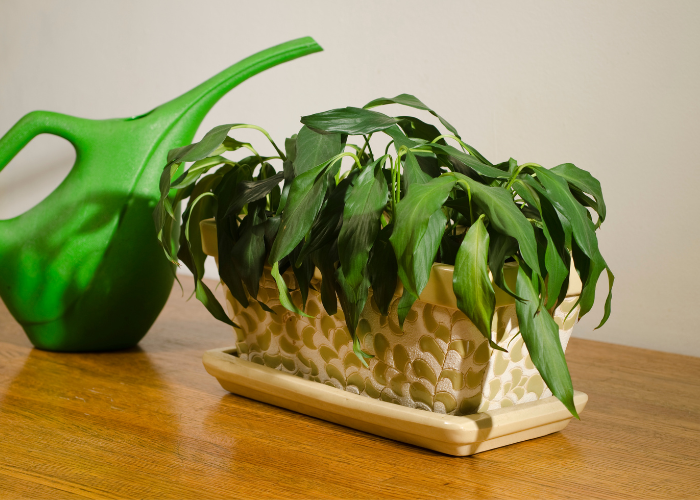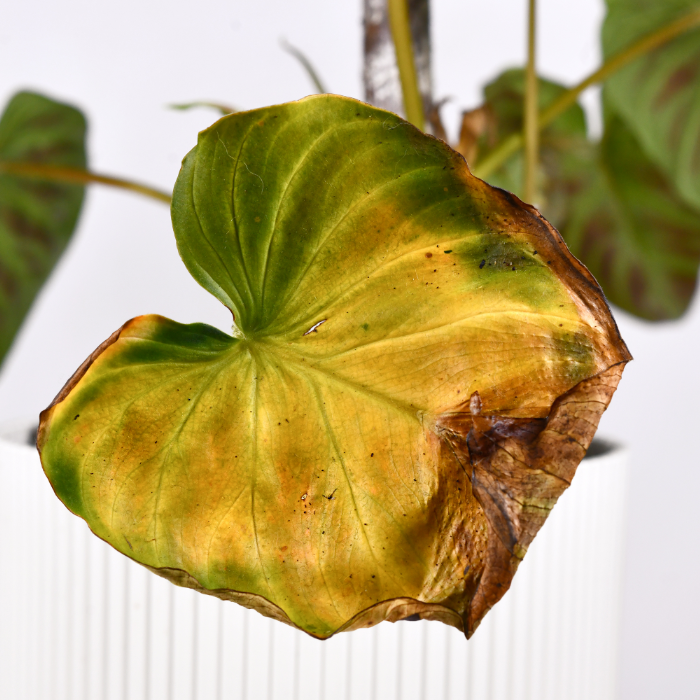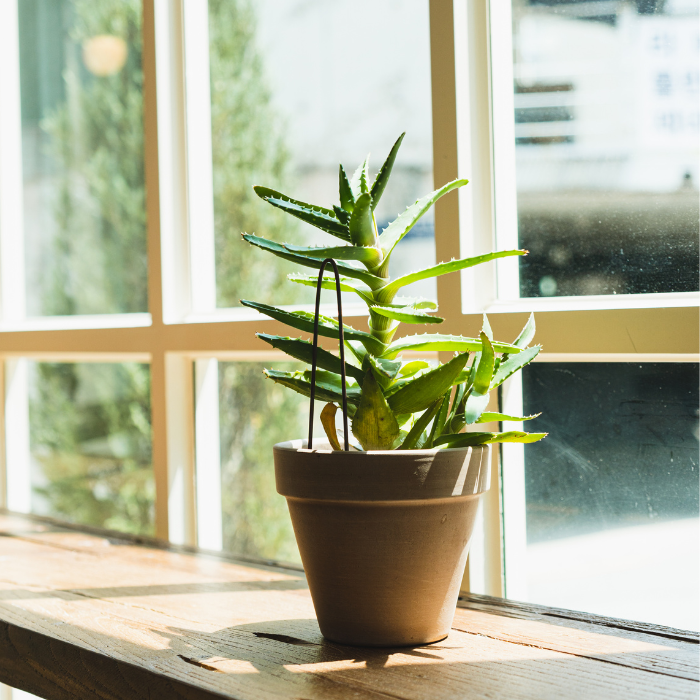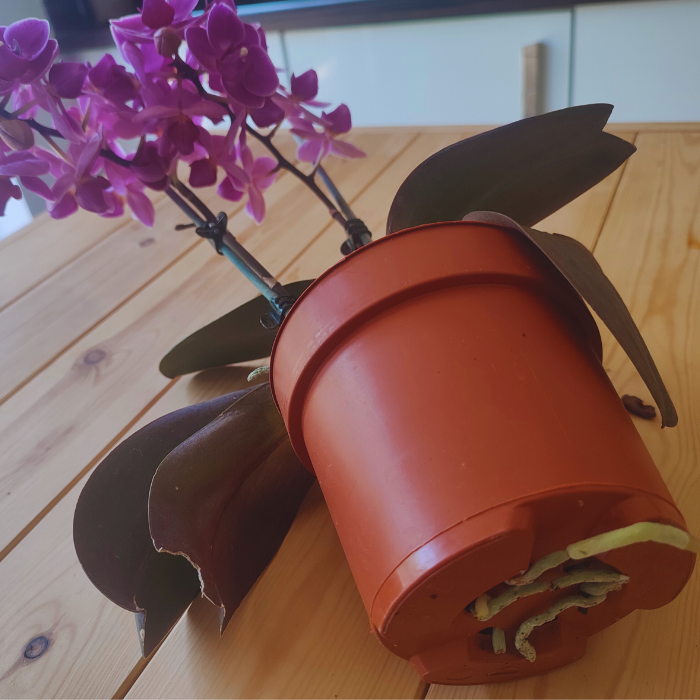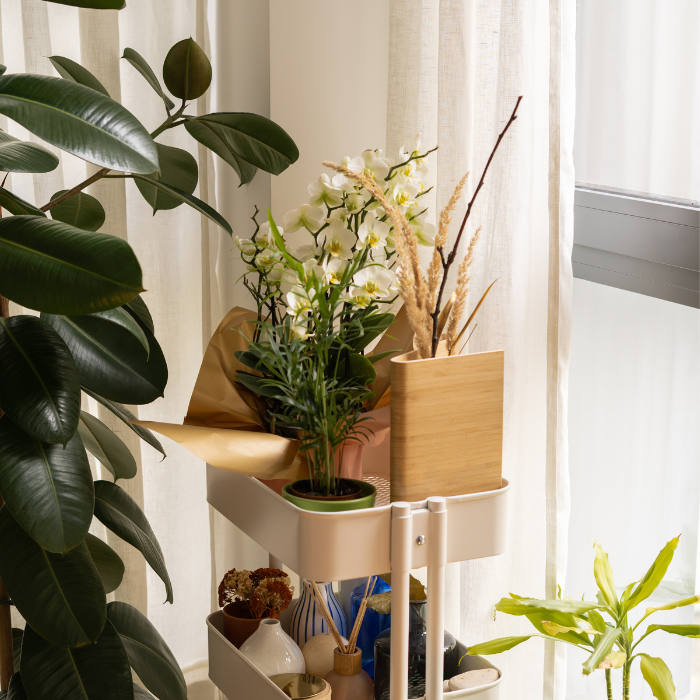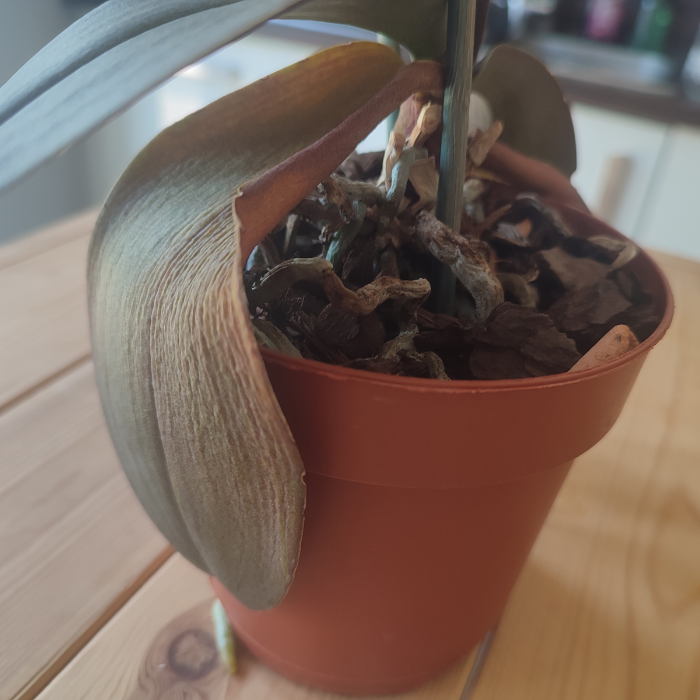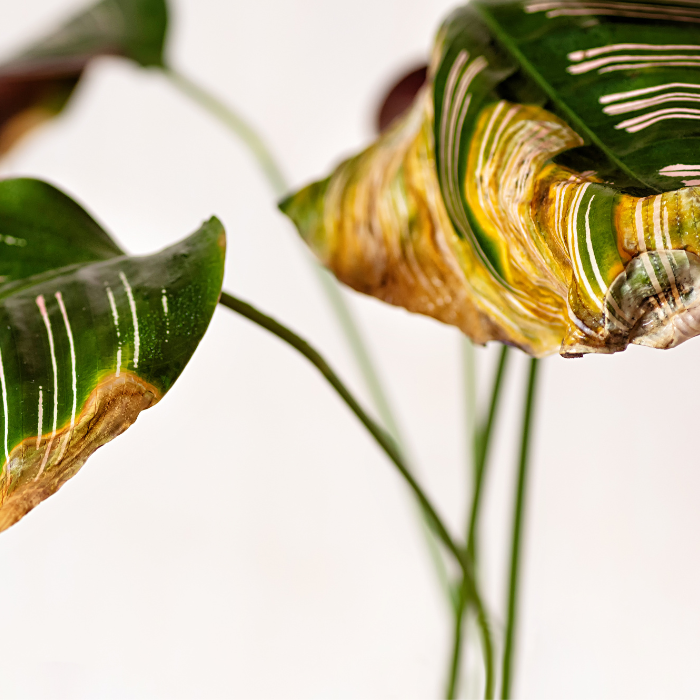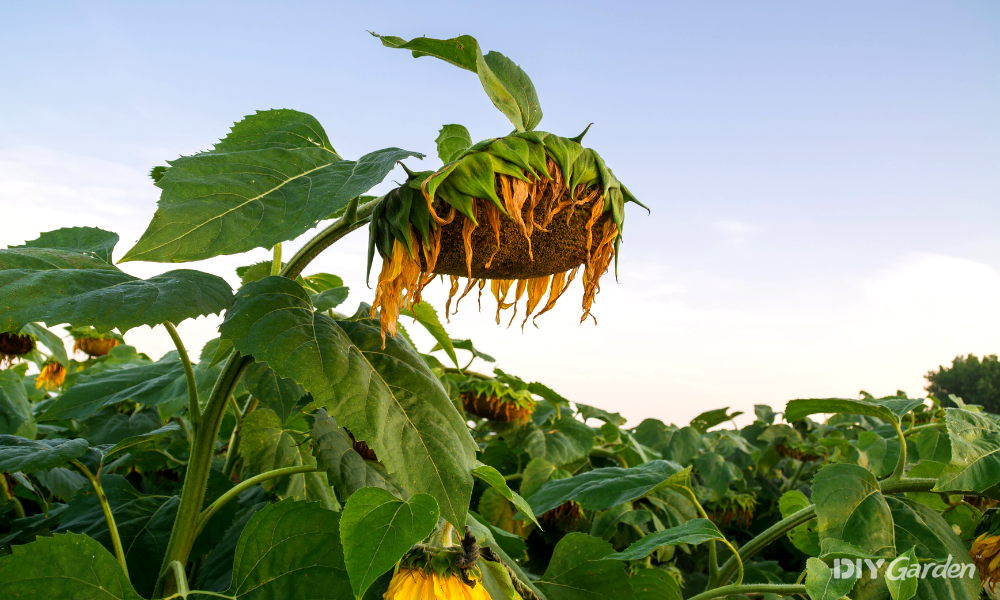
Have you ever watched helplessly as your beloved houseplant droops, with no clue how to revive it? Fear not – you’re not the first, and you certainly won’t be the last!
I’m here to guide you through the many causes why you may have a drooping plant and solutions to keep each plant healthy and happy!
Together, we’ll explore how to distinguish between overwatering and underwatering, find that perfect light spot, tackle rootbound problems, and create the ideal environment for your plant to thrive.
Key Takeaways
- Identify the cause of houseplant and outdoor plant drooping.
- Balance between overwatering and underwatering is essential for keeping plants healthy.
- Understand your plant’s light, temperature & humidity needs to keep it thriving!
Understanding Plant Drooping: Common Causes
Got a wilting plant on your hands? Plant drooping can be caused by many factors, from issues with watering to pesky pests attacking your precious plant’s leaves. If you’ve ever wondered why your fiddle leaf figs are drooping, it could be due to too much light, root rot or even a lack of nutrients in the soil.
The main culprit behind drooping houseplants is often watering – either over watering or too little water. However, several factors can contribute to your plant’s distress.
Understanding the cause of your drooping plant is vital to getting it back on the path to health. So, whether you’re struggling to manage plant wilting or are trying to revive a plant with drooping leaves, identifying the root cause and provide the necessary care to nurse it back to health are essential.
Watering Woes: Overwatering vs. Underwatering
If you’ve ever kept a plant, you’ll know how easy it is to get the watering part wrong. But how can something so seemingly simple be so complex? I remember my very first attempts at plant parenting – even the cactus didn’t survive! And the orchid that followed was the first of my droopy plant collection.
Striking a balance between overwatering and underwatering isn’t always easy, but it’s crucial for maintaining a healthy, happy plant. So, what’s the difference between overwatering and underwatering?
Overwatering
Overwatering occurs when you give your plant too much water, causing the soil to become waterlogged. This can lead to wilting, yellowing plant’s leaves, and even root rot as the plant’s tissues become oversaturated. If you suspect your plant is suffering from overwatering, give your plant a break and let the soil dry out completely before watering again, allowing the roots to breathe and recover.
Also, ensure that your plant has enough sun, as overwatered leaves may not receive enough sun to support the plant’s growth. Providing adequate sun and maintaining a healthy environment can help your plant bounce back from overwatering and prevent future issues.
Underwatering
On the other end of the spectrum, underwatering is when a plant isn’t receiving enough water, leading to dry leaves without yellowing. If you’re a busy or forgetful person, you’ll know the feeling of catching your wilting plant in the corner of your eye and thinking, uh oh. When was the last time I watered you?
But don’t worry; there’s an easy fix. First, check if the soil feels dry by sticking your finger about an inch into the soil.
If it’s bone dry, it’s time to increase the watering frequency to prevent further water loss, providing your plant with the necessary hydration it craves.
Remember, consistency is key. Just like with overwatering, providing a stable environment with the right amount of light and proper care can help your plant recover from underwatering and thrive in its new, well-hydrated state.
Remember to water all of your houseplants in the morning rather than the evening as this will keep your plants wet enough until you water them next. You can use this same trick for your outdoor plants!
Light Requirements: Finding the Perfect Spot
Finding the perfect spot for your plant to receive the right amount of light is crucial for its health and happiness.
But how do you know if your plant is getting too much or too little light? If you’ve ever found yourself getting confused over the difference between “direct” and “indirect” light, I hear you!
Let’s explore the effects of excessive and insufficient light on your plant and how to adjust its environment accordingly.
Too Much Light
Excessive light can be harmful to your plant, causing physical symptoms such as drooping plant’s leaves, burning, yellowing, and browning. In extreme cases, excessive light can lead to photooxidative stress and even cell death.
If you find your plant is being exposed to too much light, it’s time to take action.
Gently move the plant to a less intensely lit spot, but do so gradually to avoid shocking the plant and causing further stress. Because who wants to feel stressed, right?
Remember, each plant has its unique light requirements, so it’s essential to understand the specific needs of your plant and adjust its environment accordingly.
Providing the right amount of light can significantly impact your plant’s overall health and well-being.
Insufficient Light
Just as too much light can be harmful, not getting enough light can lead to weak, stretched-out growth, lack of vibrancy in colour, and even plant death.
It can also stunt growth and reduce blooming and fruit production. If your plant is not receiving enough light, you can gently move it to a brighter spot but do so gradually to avoid causing unnecessary stress.
However, this is where deep shade-loving plants come in! If you have a room without a window you desperately want to place a plant in, choose a deep shade-loving plant that can handle limited light!
READ NEXT: 21 Best Plants for Rooms Without Windows
Understanding your plant’s unique light requirements is essential for creating a thriving environment. By adjusting your plant’s location and ensuring it receives the right amount of light, you can promote healthy growth and prevent issues related to insufficient lighting.
Pot Size Matters: Identifying Rootbound Plants
The size of your plant’s pot plays a crucial role in its overall health and growth. A plant in a pot that’s too small can become rootbound, while a pot that’s too big can lead to overpotting issues.
Let’s delve into the signs of a rootbound plant and the solutions available to address this problem.
Signs of a Rootbound Plant
A plant becomes rootbound when its root system has outgrown their pot, leading to stunted growth, yellowing or disfigured plant’s leaves, visible roots above the soil surface, and roots poking through the drainage holes.
A rootbound plant may also display wilting, yellowing, and stunted growth, indicating it’s time for a change.
Identifying a rootbound plant is the first step to addressing the issue. Once you recognise the signs, it’s essential to consider repotting solutions, as a rootbound plant requires more room for nutrients and water to thrive.
Repotting Solutions
Repotting is a must for rootbound plants, as the bigger pot provides them with the additional space they need to grow and absorb nutrients properly. And don’t forget a good ol’ drink of water after potting! The best time to repot a plant is between March and September, ensuring optimal growth and recovery.
There are several repotting solutions to consider, such as transferring the plant to a larger container, pruning the roots and repotting in the same pot, or cutting the roots to loosen them before putting in a new pot. Each method has its benefits, but the key is to provide your rootbound plant with the space it needs to flourish.
READ NEXT: The Foolproof Guide to Container Gardening
Temperature & Humidity: Creating the Ideal Environment
Maintaining the right temperature and humidity levels is essential for plant health, as they directly impact the plant’s ability to photosynthesise, absorb water and nutrients, and regulate transpiration rates.
Let’s explore how temperature fluctuations and humidity levels can affect your plant’s well-being and how to create the ideal environment for it to thrive.
Temperature Fluctuations
Temperature fluctuations can cause plants to sag because the moisture leaves the plant’s leaves faster than the roots can absorb it.
To avoid wilting due to temperature fluctuations, keeping your plants in a warm and stable environment is crucial and away from excessive heat! Give your plant a week to see if there’s any improvement; if not, you might want to seek professional help.
Remember, each plant has its unique temperature requirements, so it’s essential to understand the specific needs of your plant and adjust its environment accordingly. Providing the right temperature can significantly impact your plant’s overall health and well-being.
Humidity Levels
Low humidity can cause drooping, particularly in tropical rainforest plants. To fix this problem, try placing the plant on a tray full of gravel that is half-filled with water, misting the plant’s leaves at least once a day, or investing in a humidifier to run near the plant.
Understanding your plant’s unique humidity requirements is essential for creating a thriving environment. By adjusting your plant’s location and ensuring it receives the right amount of humidity, you can promote healthy growth and prevent issues related to low humidity.
Age-Related Drooping: Recognising Natural Leaf Shedding
Just like us, as plants age, they change. They may naturally shed a leaf or two, causing wilting near the bottom of the plant.
This is simply a part of the plant’s lifecycle, and it’s essential to recognise this process to care for your plant effectively.
To encourage new growth and maintain your plant’s health, snip off any wilted plant’s leaves near the bottom of the plant. This will not only make your plant look more appealing but also help promote new growth and prevent any potential issues related to age-related leaf shedding.
Pests & Diseases: Detecting Unwanted Visitors
Pests and diseases can wreak havoc on your plant’s health, reducing its yield and productivity. Detecting pests and diseases early is key to preventing them from spreading and causing further damage. Regularly inspecting your plants for signs of pests or disease can help you catch them early and take care of them.
Common Indoor Plant Pests
Several common indoor plant pests, such as aphids, fungus gnats, scale, spider mites, mealybugs, and whiteflies, can cause significant damage to your plants.
Detecting these unwanted visitors involves checking for tiny pests under the leaves that suck sap, leading to a loss of moisture. Keep an eye out for discoloured or wilted leaves, webbing on the leaves, or small insects on the leaves or stems of the plant, as these are all signs of an infestation.
Once you’ve identified the pests plaguing your plant, it’s time to take action. One hack for indoor plants is to create a natural pest deterrent spray by mixing a solution of equal parts water and white vinegar in a spray bottle and adding a few drops of dish soap. Shake well, then spray it on the leaves and around the base of your indoor plants.
The strong smell and taste of vinegar repels many common pests, such as aphids and spider mites. Reapply the spray every week or after watering your plants.
Disease Prevention & Treatment
Preventing and treating plant diseases involves providing adequate water, light, and nutrition to ensure your plant remains healthy and resistant to any potential threats.
It’s essential to identify the disease and take the appropriate steps to prevent it from getting worse. This could involve removing any affected plants or tissues, using fungicides, and ensuring the growing conditions are ideal for your plant.
By staying vigilant and taking the necessary precautions to prevent and treat pests and diseases, you can ensure your plant’s health remains in excellent condition, allowing it to thrive and bring life to your home.
Summary
In conclusion, plant drooping can be caused by various factors, from overwatering to insufficient light, rootbound pots, temperature fluctuations, and pests or diseases.
Armed with the knowledge and tools to identify and address these issues, you’re now well-equipped to care for your plants and create an environment in which they can flourish.
Remember, a healthy plant is a happy plant, and a happy plant brings joy and life to your space.
Frequently Asked Questions
Can a drooping plant recover?
Yes, drooping plants can recover with proper care. Give it some water and time to rest, or check for other causes of wilting such as pests, stress, disease, low humidity, overwatering, etc. With the right conditions, a drooping plant should soon be healthy and vibrant again.
Why are my houseplants drooping?
It looks like your houseplants are drooping because they may be suffering from a lack of water.
If this is the case, you should try giving them a good drink and increasing humidity levels to help revive them before looking into other issues such as pests, moisture, stress, disease, and fertiliser. It’s worth giving it a try, so give them some love and care, and they should perk right up!
Why has my plant gone floppy?
It’s likely that your houseplant has gone floppy due to an imbalance in watering, either too much or too little.
When a plant is underwatered, its leaves become dry and crispy, while when it is overwatered, its leaves appear soft and limp. If you see a leaf wilting, jump into action! Ensuring the right balance of water for your plant will help bring it back to life.
Why do plants wilt?
Plants wilt when they can’t keep up with their demand for water, usually because the environment is too hot or dry. With less available water, the water chains in the xylem become thinner, making it harder for the plant to absorb water and retain its turgidity.
This results in a wilting or droopy plant.
If you enjoyed this article and want to know more about how to perfect watering, check out our article, How Often Should You Water New Plants?
